Mitac Digital Technology PF11 GPS Portable Navigation Device User Manual
Mitac International Corporation GPS Portable Navigation Device
User manual
User Manual
GPS PF11
Thanks for using YF GPS PF11!
YF reserves the rights of final interpretation of the manual.
The manual content is subject to change without notice. Please accept our
apology for your inconvenience.
Please back up your data of the GPS navigator. YF assumes no responsibility for
any loss caused by data loss.
The manual might contain a few mistakes though it has been checked. If mistakes
are found, you are welcome to contact the YF customer service center.

Please read the instructions in this manual and use only accessories of YF to
avoid unpredicted damage. Failure to follow the instructions will invalidate
warranty and might endanger personnel safety, for which YF assumes no
responsibility.
Data of navigation electronic maps might be inconsistent with actual traffic signals
due to transportation development. Please follow traffic regulations and signs and
drive according to road situation. Operating the GPS navigator device while
driving might cause serious accidents. YF assumes no responsibility for accidents
and loss due to improper use.
For information of software update and upgrade, please go to our website
www.yftech.com.
The pictures in the manual are subject to the material object.
Welcome ................................................................ 1
Chapter I Beginning Use ......................................... 2
1.1 APPEARANCE ............................................................ 2
1.2 POWER SUPPLY & CHARGING ....................................... 2
1.3 BASIC USE ............................................................... 3
1.4 SYSTEM MAIN INTERFACE AND MAJOR FUNCTIONS ............. 5
Chapter II Navigation .............................................. 7
2.1 INSTRUCTION ............................................................ 7
2.2 OPERATION ............................................................... 7
2.3 THE PLAYER OF DVR .................................................. 10
Chapter III Function Operation ................................ 11
3.1 MUSIC PLAYER .......................................................... 11
3.2 VIDEO PLAYER ........................................................... 13
3.3 PHOTO BROWSER ...................................................... 15
3.4 E-BOOK READER ........................................................ 18
3.5 FLASH PLAY .............................................................. 22
3.6 THEME ..................................................................... 22
3.7 WALLPAPER .............................................................. 23
3.8 FAVORITES ............................................................... 24
3.9 EXPLORER ................................................................ 25
3.10 CALENDAR .............................................................. 26
3.12 SYSTEM RESOURCE .................................................. 27
3.13 CALCULATOR ........................................................... 27
3.14 UNIT ...................................................................... 28
3.15 GPS INFO .............................................................. 28
3.17 VOLUME ................................................................. 29
3.18 BACKLIGHT ............................................................. 30
3.19 LANGUAGE .............................................................. 30
3.20 DATE& TIME ............................................................ 31
3.21 CALIBRATION ........................................................... 31
3.22 RESTORE FACTORY SETTING ...................................... 32
3.23 USB SETTING .......................................................... 33
3.24 SYSTEM INFO .......................................................... 35
3.25 NAVIGATION PATH ..................................................... 35
3.26 OTHELLO ................................................................ 35
3.27 BOXMAN ................................................................ 36
3.28 RUSSIA BLOCK ......................................................... 36
Appendix Troubleshooting ..................................... 37
4 FCC statement .................................................. 37
Welcome
Thanks for using GPS PF11-5001. It is featured with navigation function , audio & video
play, photo browsing and e-book functions.
SiRF Atlas-Ⅴ CPU with high performance and low power consumption
Friendly user interface for simple operation
Power management for longer and more stable operation
Data transmission with computer via Mini USB
Quality reception, accurate positioning and satisfactory navigation service
Leisure friend with audio/video/amusement functions
You may use the GPS navigator anytime anywhere, for example while driving, walking or
cycling. Let its navigation and amusement functions enrich your life and work!
To realize the functions of GPS PF11-5001 and to understand the operation details, please
read the manual carefully.
You may see the following supplemental information in the manual.
[Note]: Explanation of relevant subjects
[Relevant Information]: Extra information of relevant subjects
[Attention]: Precautions or warnings of relevant subjects. Please pay attention to this
information and follow the instructions to avoid devastating influence on yourself and
others.
[*]: Optional function
This manual is applicable only to the GPS PF11-5001.
1
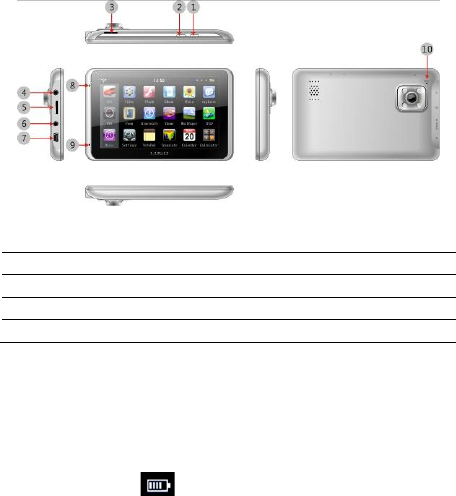
Chapter I Beginning Use
This chapter introduces the basic operations of GPS PF11-5001.
1.1 Appearance
The product picture below is subject to the material object.
1. Lock Key
6. VIDEO-IN Port
2. Power key
7. MINI USB Port
3. T-Flash slot for DVR only
8. Indicator light
4. Earphone Port
9. Microphone
5. T-Flash Port
10. Reset key
1.2 Power Supply & Charging
Charge the GPS navigator fully with the charger before first use.
1.2.1 Power Supply
The GPS PF08 can be powered by the built-in battery or external power supply.
When the GPS navigator is unconnected to the charger, it is powered by the Li-polymer
battery.
The battery capacity icon in the system main interface shows current residual
battery capacity.
When the GPS navigator is connected to the charger, it is powered by external power and
2

the battery is charged.
[Attention] The GPS navigator adopts internal non-removable Li-polymer battery. To avoid
battery rupture, explosion, release of hazardous substance or burn, do not unpack, pierce,
strike on or discard the battery in fire or water.
1.2.2 Charging by DC Charger
The GPS navigator must be charged with the DC charger before first use.
Plug the USB terminal of the DC charger into the USB port of the GPS navigator and the
other to the power socket to supply power and charge the GPS navigator.
[Note] The charging indicator light is red during charging. Do not unplug the charge until
the battery is fully charged and the indicator light turns green. Please charge the GPS
navigator when the battery is low or used up.
1.2.3 Charging by Car Charger
Plug one terminal of the car charger into the USB port of the GPS navigator and the other
to the charging port to supply power and charge the GPS navigator.
[Note] To avoid damage due to current surge, plug in the car charger after the automobile
is started.
1.3 Basic Use
1.3.1 Powering on/off & Sleep
1.3.1.1 Powering on
Press the power key of the GPS navigator and let go after at least two seconds to power it
on.
[Note] Great humidity fluctuation may lead to short circuit of the GPS navigator. Power on
the navigator after it has accommodated to new environment.
1.3.1.2. Powering off & Sleep
Press the power key and let go after at least two seconds to power off the GPS navigator.
The following interface will be prompted. If is selected, the navigator will
automatically resume the state before entering sleep mode when it is powered again.
3
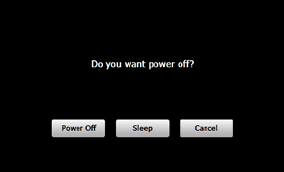
1.3.2 Restarting the System
When the system does not response, press the reset key on the back of the GPS
navigator to restart the system.
[Relevant Information] The following situations might lead to no response of the system.
1. Delay or pause in interface switching;
2. Failure of function activation with overlong execution;
3. Failure to power on/off the GPS navigator by pressing the power key.
[Note] Restarting the system by pressing the reset key will result in loss of unsaved data.
Please backup your data regularly.
1.3.3 Fixing the GPS Navigator with Mounting Kit
The mounting kit is composed of a back splint and a bracket. To use the GPS navigator in
an automobile, fix it on the dashboard under the front windshield.
[Note] Do not place the GPS navigator in positions obstructing the driver’s vision. Do not
place it without fixing it or in the place of air bag or the area after the air bag is inflated.
1.3.4 Using T-FLASH Card
Copy mapping applications, map data and media files in a T-FLASH card. Insert the card
in the corresponding slot.
[Note] 1. Do not take out the T-FLASH card while a navigation program is being run or
a media file is being played.
2. To avoid drop or crash of the T-FLASH card, do not exert heavy pressure on
it or bend it.
3. Avoid using or storing the T-FLASH card in high temperature, high humidity
or direct sunlight.
4
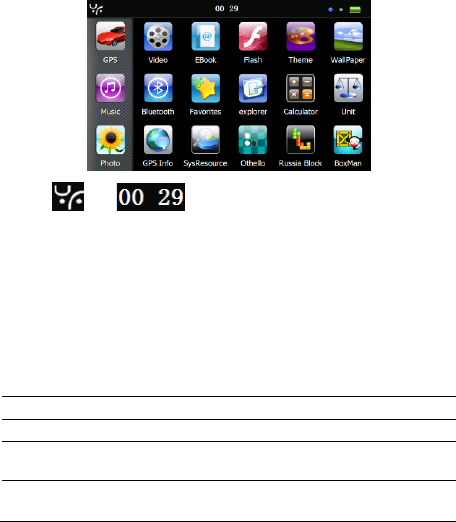
Keep the card away from liquid or corrosive substance.
4. Mind the direction while inserting the T-FLASH card to avoid damaging the
slot or the card.
1.4 System Main Interface and Major Functions
Long press the power key on the top side of the GPS navigator to enter the system main
interface shown below.
The icon and are shortcuts to view system information and set
time & date for the device. For details, please refer to relevant chapter and section.
[Relevant Information]: In the above interface, the icon style is set as “left”, and the icons
at the left remain during page scrolling. To change the style of icon layout, refer to 3.6
Theme.
[Relevant Information]: To rearrange icons at will, tap on an icon and stay until a four-way
arrow appears at the upper left of it, and then drag the icon to a wanted place.
Function
Explanation
GPS
Tap to enable navigation function
DVR
Tap to enable DVR function
Tool
Calculator , Unit, system information, favorite, calendar ,GPS
information
Media
JPG
,
GIF
,
BMP and PNG files supported;
Photo rotation, zoom in/out and auto play supported
5

Setting
Volume, backlight, language, date& time, calibration, system info,
USB setting and Factory reset
Game
Othello, DuiDuiPeng, Russia Block
6

Chapter II Navigation
Tap the icon in the system main interface to start the navigation program. For
detail usage, please refer to the electronic map instruction.
Due to transportation development, inconformity between products and
real traffic information will occur a period after product release. Please
drive according to road condition and abide by traffic regulations.
Navigation paths are for reference only, and the user may decide whether
to follow them.
High and crowded structures (such as inside of tunnels, space between
high buildings, underground car parks and under viaducts), weather
change or satellite signals turnoff may influence signal reception,
resulting in positioning failure, inaccurate positioning, navigation failure or
system function abnormity.
With stereoscopic maps, instant animation, voice prompt and text prompt of the navigation
system, you will appreciate its unique charm and enjoy a great trip.
Function of DV recorder (Drive video record)
This section introduces the usage of the DVR.
2.1 Instruction
1、The function of DVR need match with TF card
2、Requirement of TF card is 4 grade; Capacity should be 4G at least.
3、Format the TF by special form at 1st time usage,, you can choose it under the format
setting
4、The player of DVR will create automatically after formatted
5、There are 3 lock manner (hand-driven lock, top lock on device ,G-sensor lock) for
DVR’s video ,
2.2 Operation
2.2.1 Interface of DVR
。
Tap the icon in the system main interface to enter the DVR interface as follows:
7
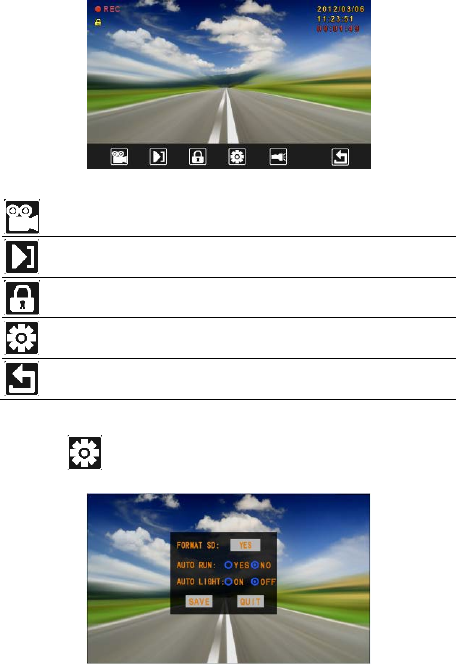
Turn
No/off
Tap to start-up& turn off video
Playback
Tap to player the recorded video
Lock
Tap to lock the recording video (Avoid erased during the period of
cycling video)
Setting
Tap to setting / format the TF card/ setting startup method of video
Return
Tap to quit the DVR interface(if you did not turn off video for quit, it
will still run behind)
2.2.2 Setting interface of DVR
Tap the icon in the DVR main interface to enter the setting interface as follows:
8
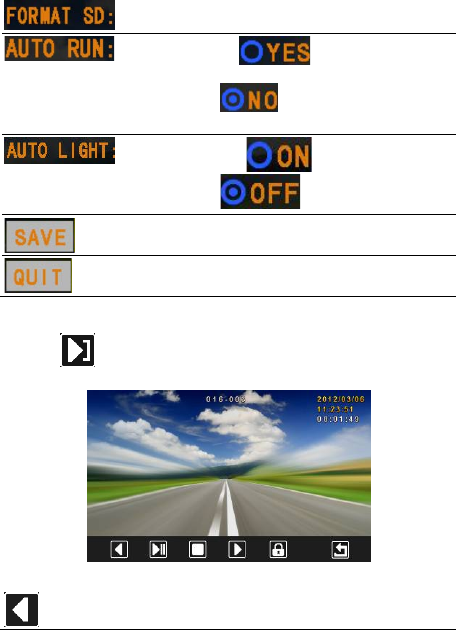
Formatting
Tap “confirm” to Format the TF,
Start video
manner Tap and Save, it will running
behind automatically when power on /Tap
and Save, it will
running by
manually to turn on video.
Light
Tap
to turn no the light Tap
to turn off
Save
Tap to save current video
Quit
Tap to Quit setting interface
2.2.3 Playback interface of DVR
Tap the icon in the DVR main interface to enter the player interface as follows:
Previous
Play the previous video
9
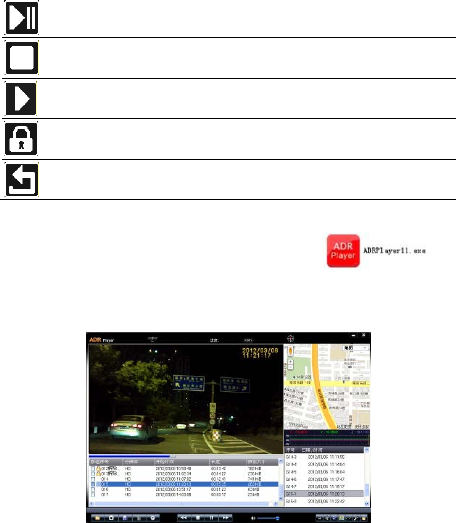
Play/ Pause
Pause/continue playing
Stop
Stop playing the current video
Next
Play the previous video
Lock
Tap to lock & unlock current video
Return
Tap to return the main interface
2.3 The Player of DVR
The Player will create automatically after formatted, this file will
shown on the screen once open the TF card on computer, we can save picture,output the
vedio file and map information,when duble tap it.
10
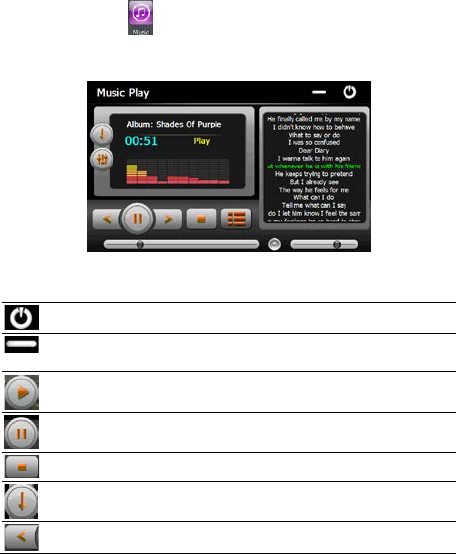
Chapter III Function Operation
3.1 Music Player
The music player supports WMA9 and WAV files and also supports selection of play
sequence. To use the function, please first insert a flash card with music files inside.
1. Tap the music icon in the system main interface to enter the Music Play
interface as follows:
Icon
Name
Explanation
Close
Close the music player.
Minimize
Minimize the music player and return to the
system main interface.
Play
Continue playing the paused/ stopped music.
Pause
Make the playing music pause.
Stop
Stop playing the music.
Set play
sequence
Select sequence, random or cycle play.
Previous
Play the previous music.
11
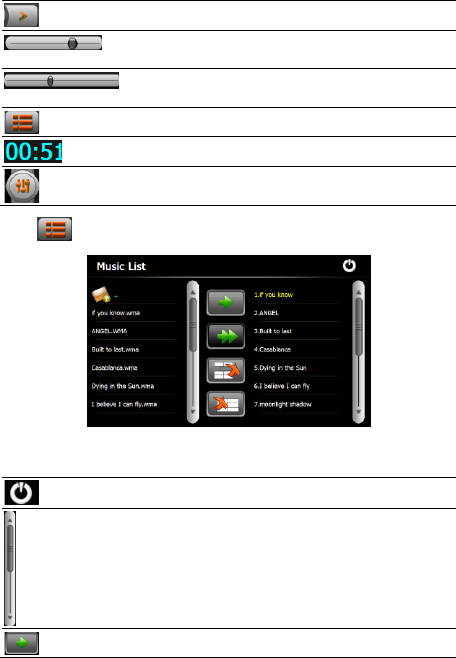
Icon
Name
Explanation
Next
Play the next music.
Volume
regulation
Drag it leftward/ rightward to turn down/ up the
volume.
Progress
regulation
Drag it leftward /rightward to play from a
previous/future moment.
Music list
Enter it to select music to play.
Time
Display the run time.
Equalizer
Enter the equalizer.
2. Tap in the Music Play interface to enter the Music list as follows:
Icon
Name
Explanation
Close
Close the Music List.
Scroll bar
Drag it upward/ downward to view all music.
Add one
Add a piece of music on the left list to the play list on the right.
12
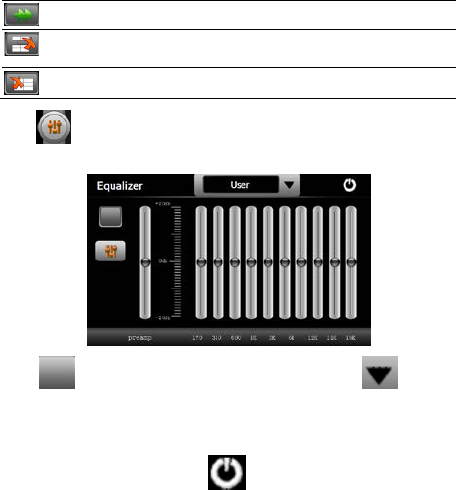
Icon
Name
Explanation
Add all
Add all the music on the left list to the play list on the right.
Delete one
Select one piece of music in the play list and tap the icon to delete
it.
Delete all
Delete all the music in the play list.
3 Tap in the Music Play interface to enter the Equalizer Setting interface as
follows:
Tick in on the upper left of the above interface, and then tap to select a
music type or “User” from the drop-down menu.
The music types include Pop, Rock, Metal, Dance, Electronic, Country, Jazz, Oldies,
Blues, Nostalgia, Opera and speech. If “User” is selected, you may drag the slider at will
to set the equalizer. After setting, tap to save and return to the Music Play
interface.
Note: If your memory card contains corresponding lyric files for the music being played,
lyrics will be displayed in the lyric window right at the Music Play interface. Double tap the
lyrics window to view the lyrics in full screen. Under full screen mode, double tap the
screen to return to normal-sized interface.
3.2 Video Player
The video player supports WMV, ASF and AVI files, full-screen play, progress selection
and file selection.
13
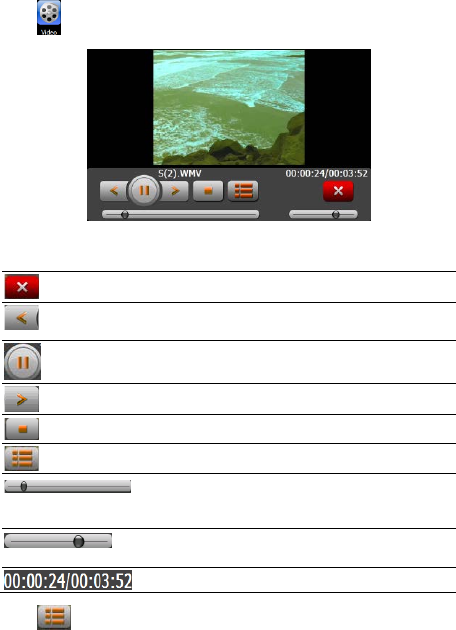
To use the function, please first insert a flash card with video files inside.
1. Tap in the system main interface to enter the video player interface as follows:
Icon
Name
Explanation
Close
Close the video player.
Previous
video
Play the previous video.
Play
Continue playing the paused/ stopped video
file.
Next video
Play the next video.
Stop
Stop the video
Video folder
Enter it to select a video to play.
Progress
regulation
Drag the sliding block leftward to play from a
previous moment or rightward for a coming
moment.
Volume
regulation
Drag it leftward /rightward to turn down / up the
volume.
Time
Display the play time and the video duration.
2. Tap in the Video Player interface to enter the video folder as follows:
14
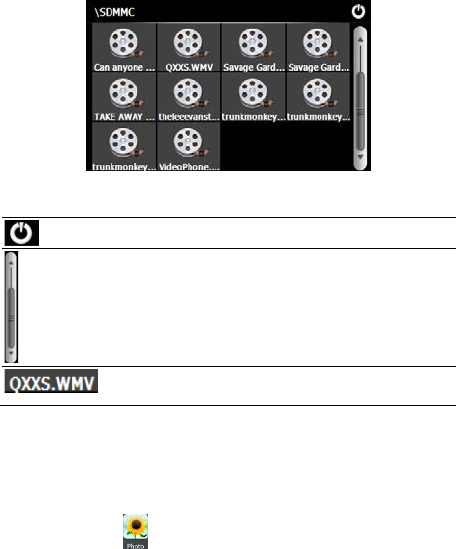
Icon
Name
Explanation
Close
Close the video folder.
Scroll bar
Drag the sliding block upward/ downward to view
all the files
under the folder.
Video name&
format
Video name and its format
Select a video file from the above video folder interface and then tap on it to start playing.
3.3 Photo Browser
The photo browser supports JPG, GIF, BMP and PNG files, photo rotation, zoom in/ out
and auto play.
To use the function, please first insert a flash card with photos inside.
1. Tap the photo icon in the system main interface to enter the photo browser
interface as follows.
15
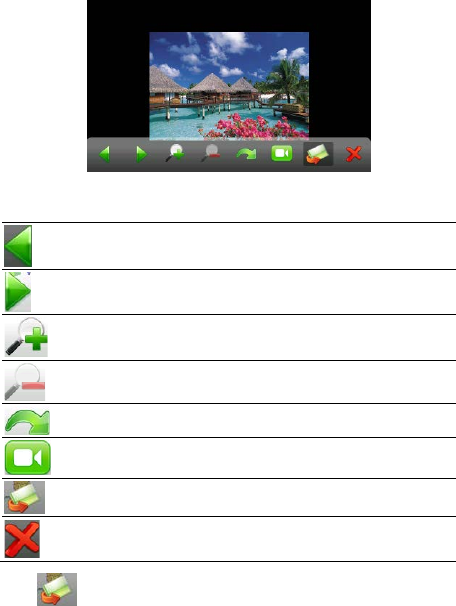
Icon
Name
Explanation
Previous
View the preview photo in the folder.
Next
View the next photo in the folder.
Zoom in
Scale up current photo.
Zoom out
Scale down current photo.
Rotate
Rotate current photo 90°clockwise.
Auto play
Cycle play all the photos in the folder from current photo.
Folder
Enter the photo folder to select a photo.
Close
Close the browser and return to the system main interface.
2. Tap in the browser interface to enter the photo folder as follows:
16
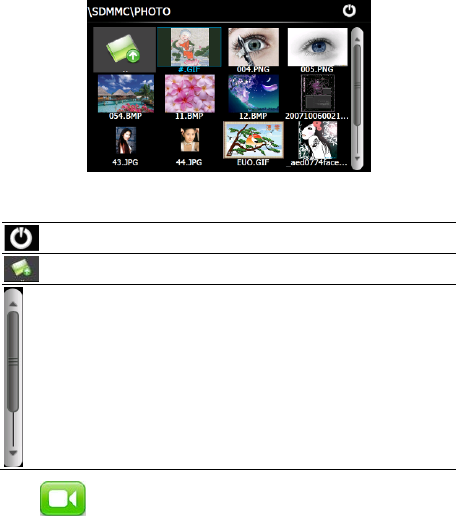
Icon
Name
Explanation
Close
Close the current folder.
Return
Return to the previous folder.
Scroll bar
Drag the sliding block to view all the photos.
3. Tap to enter auto play interface as shown below. Drag the slider at the
bottom of the screen to regulate play speed (1-10 seconds), and then tap on the screen to
hide the slide (or the slide will be hidden automatically); tap on the screen to show the
slide. Double tap on the screen to stop playing and return to the browsing interface.
17
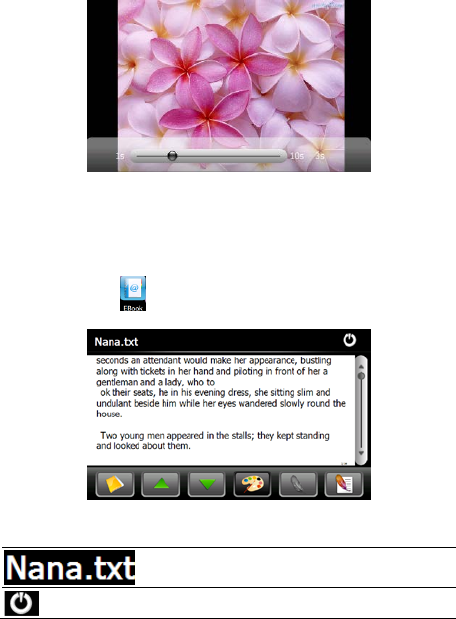
3.4 E-book reader
The reader supports text files in .txt format, page turn and folder selection.
To use the function, please first insert a flash card with text files inside.
1. Tap the e-book icon in the system main interface to enter the reader interface as
follows.
Icon
Name
Explanation
Text name&
format
Current file name and format
Close
Close the reader.
18
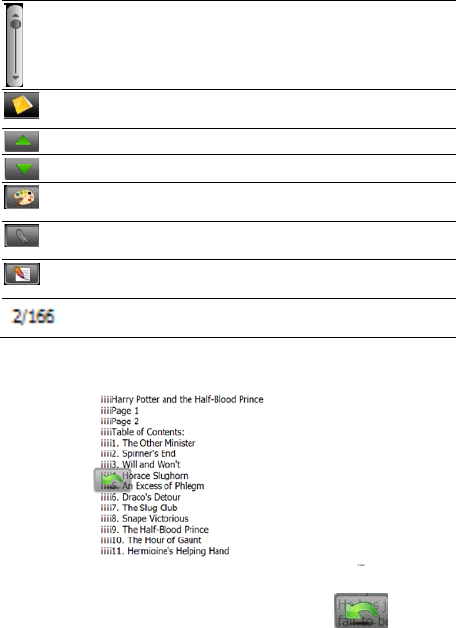
Icon
Name
Explanation
Scroll bar
Drag the sliding block upward/ downward to
view all content of the e-book.
Folder
Enter the e-book folder to select an e-book to
read.
Previous
Read the previous page.
Next
Read the next page.
Setting
Select a text theme, font, word size and bold
type.
New
bookmark
Select partial text and tap the icon to create a
bookmark.
Bookmark list
Enter the bookmark list to select or delete a
bookmark.
Page/ total
pages
Current page/ total pages
2. In the reader interface, double tap the screen to enter to the full screen reading mode
as follows:
In the full mode reading interface, tap the upper part of the page to read the previous page,
while tap on the lower part of the page to read the next page; tap to quit.
19
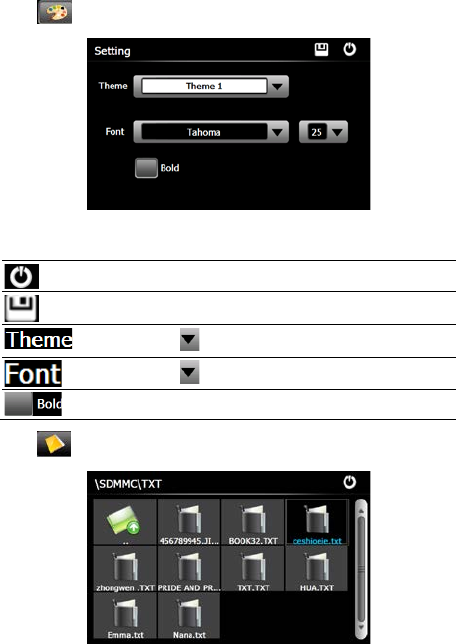
3. Tap in the e-book reader interface to enter the setting interface as follows:
Icon
Name
Explanation
Close
Exit the setting interface.
Save
Save the settings.
Theme
Tap to select a theme for the e-book.
Font
Tap to select a font for the e-book.
Bold
Tap to enable bold type. Tap it again to cancel.
4. Tap in the e-book reader interface to enter the e-book folder as follows.
20
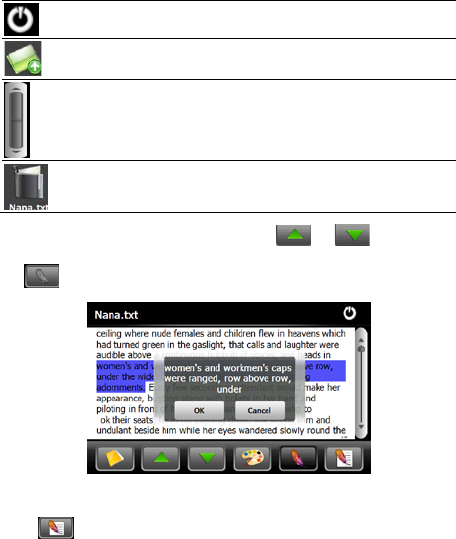
Icon
Name
Explanation
Close
Close current folder
Return
Return to the previous folder.
Scroll bar
Drag the sliding block upward/ downward to view all text
files.
File name&
format
The file name and its format.
5. To create a bookmark, locate a page by taping or or dragging the
scroll bar in the reader interface and drag to select the text content.
Tap when it is on and a dialog will popup as follows:
Tap “OK” to finish creating a bookmark or tap “Cancel” to quit the dialog.
6. Tap to view created bookmarks in the interface of Bookmark List as shown
below.
21
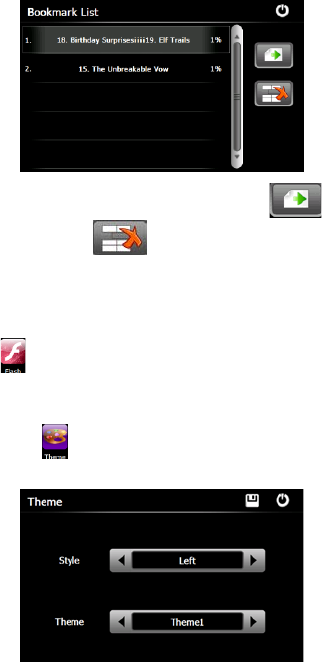
Drag the scroll bar and select a bookmark on the left list. Tap to go to the
page with the bookmark or tap to delete the bookmark.
3.5 Flash Play
The flash player supports .swf files, full-screen play, progress adjustment and file select.
To use the function, please first insert a flash card with video files inside.
Tap the icon in the system main interface to enter the flash play interface.
For detailed operation, refer to 3.2 Video Player.
3.6 Theme
Tap the Theme icon to enter the following interface to set a style and theme for the
system interface:
22
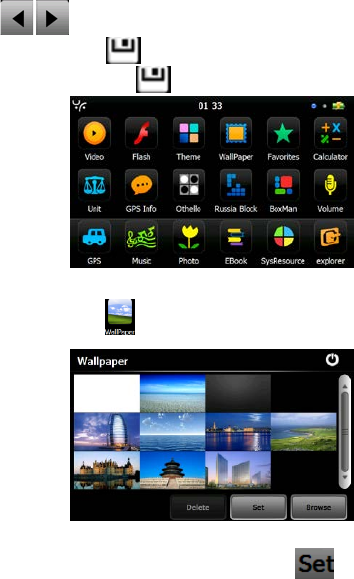
Tap /to select a mode (from “Empty”, “Left” or “Bottom”) or a theme (5 kinds of
themes in total), and tap to save the setting. For example, set the Mode as “Bottom”
and the Theme as “3”, and tap to get the following system interface effect.
3.7 Wallpaper
Tap the Wallpaper icon to enter the following interface:
1. Set wallpaper with built-in wallpaper:
Select built-in wallpaper from the above interface, and tap to get the following
effect.
23
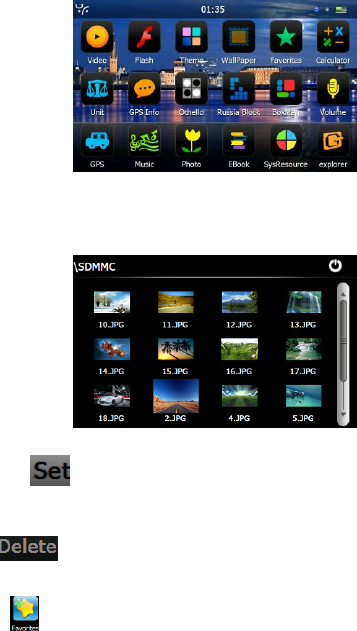
2. Set wallpaper with external image:
Insert a T-flash card with images inside into the device, and tap “Browse” to select an
image as follows:
Double tap on an image to add it to the “Wallpaper Setting” list, and then select the image
and tap to set it as the wallpaper.
[Note]: The built-in wallpapers cannot be deleted, while the added images can be deleted.
To delete images, select an added image from the “Wallpaper Setting” interface and then
tap .
3.8 Favorites
Tap in the system main interface to enter the Favorite interface as shown below.
24
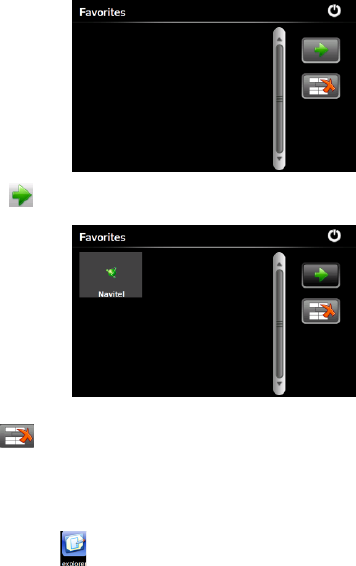
Tap in the above interface to open the directory where the application to be added
is, and then double tap the application to add it to the Favorite.
To delete applications from the Favorite, select the application in the above interface and
tap .
[Note]: While deleting the application, the shortcuts instead of application itself will be
deleted.
3.9 Explorer
Tap the icon in the system main interface to popup the following dialog box
indicating whether to enter the WINCE system:
25
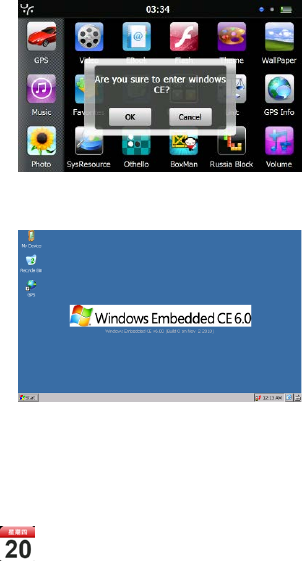
Tap
「
OK
」
to enter the WINCE system as shown below while tap
「
Cancel
」
to return to the
system main interface.
In the above interface, double tap the icon “GPS” and select “Yes” in the dialog box
popped up to return to the GPS main interface.
Note: push the Reset button at the left side of the navigator can also exit Explorer and
restart up the system.
3.10 Calendar
Tap the icon in the system main interface to enter the Calendar setting interface
as follows.
26
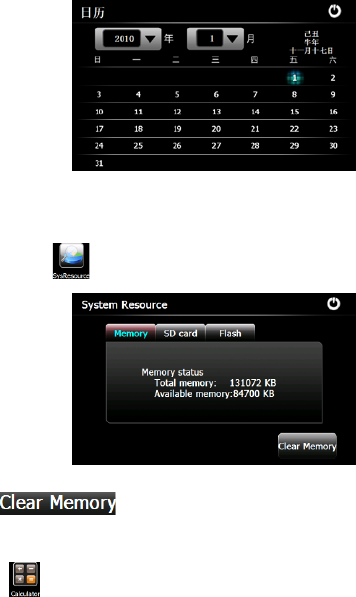
3.12 System Resource
Tap the icon in the system main interface to enter the following interface:
You may check the capacity of the memory, SD card and flash, or
tap to clear the memory.
3.13 Calculator
Tap in the system main interface to enter the calculator interface as follows:
27
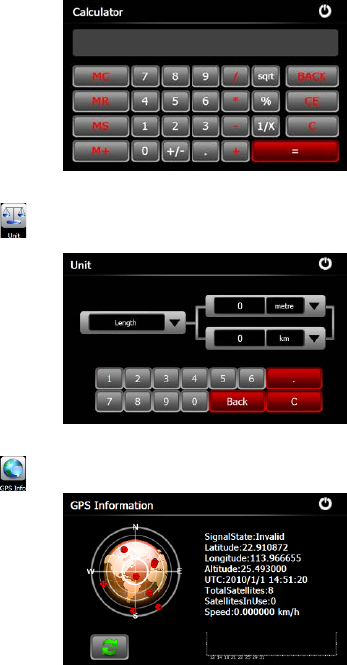
3.14 Unit
Tap in the system main interface to enter the unit converter interface as follows:
3.15 GPS Info
Tap in the system main interface to view the GPS information as shown below.
28
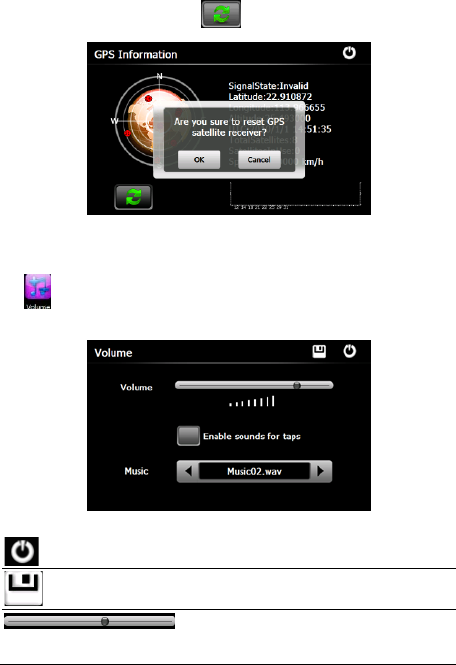
To reset the GPS satellite receiver, tap to prompt a dialog as below.
Tap OK to reset the GPS satellite or tap Cancel to exit.
3.17 Volume
Tap in the system main interface to enter the volume setting interface as shown
below.
Close
Exit the volume setting.
Save
Tap to save the settings
Volume
Ten volume grades (from mute to
maximum) available. Tap to decrease
the volume by grade.
29
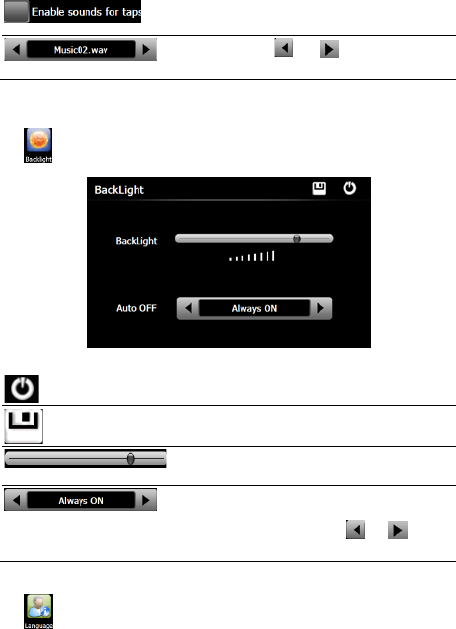
Sounds for
taps
Tap it to enable the function. Tap it again
to disable the function.
Power-on
music Tap or to select power-
on
music or disable it.
3.18 Backlight
Backlight setting includes backlight brightness adjustment and latency of backlight off.
Tap in the system main interface to enter the backlight setting interface as follows.
Close
Exit the backlight setting.
Save
Tap to save the settings
Backlight
Drag leftward to turn down or rightward to
turn up the backlight.
Auto off
Auto backlight shutoff after service stop for a
period. The options are always On, 10s, 30s,
1m, 2m and 3m. Tap or
to view
the options in cycle or select one.
3.19 Language
Tap in the system main interface to enter the language setting interface as follows.
30
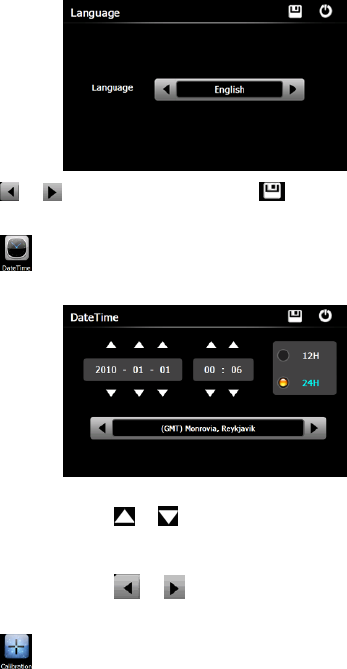
Tap or to select a system language and tap to save the selection.
3.20 Date& Time
Tap in the system main interface to enter the Date &Time setting interface as
follows.
Date & Time setting includes system date setting, time setting and time zone setting.
◆ Setting the system date and time
In the above interface, tap or to set the year, month, day, hour and minute.
[Note]: Time format options are 12-hour and 24-hour. You may select one of them.
◆ Setting the system time zone
In the above interface, tap or to select a time zone.
3.21 Calibration
Tap in the system main interface to prompt the calibration dialog as follows.
31
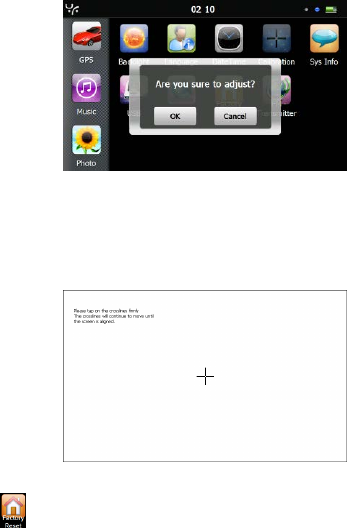
Tap OK to execute calibration or Cancel to cancel calibration and go back to the system
main interface.
Tap OK, and the following calibration interface is prompted. Click the center of cross
cursor with the touch pen and the cursor shifts from the center, upper left, lower left, upper
right and lower right to finish the calibration and the interface will be closed automatically
to go back to the system main interface.
3.22 Restore Factory Setting
Tap in the system main interface to restore the factory setting. The following dialog
will be prompted.
32

Tap OK to restore the default setting or Cancel to return to the system main interface.
3.23 USB setting
Connect the GPS navigator to PC via the MINI USB port to transmit data, or back up data
from the navigator data to PC.
The GPS navigator provides MASS STORAGE and MS STORAGE modes. Select one in
the USB setting.
◆
MASS STORAGE
1. Have the GPS navigator in operation status and the SD card plugged in the slot;
2. Tap in the system main interface to enter USB Option as follows.
Select MASS STORAGE and tap to save it.
3. Connect the MINI USB terminal of the USB cord to the MINI USB port of the GPS
navigator and the standard USB terminal to the USB Host port of PC. Then, the computer
will recognize the navigator and prompt the following interface.
33
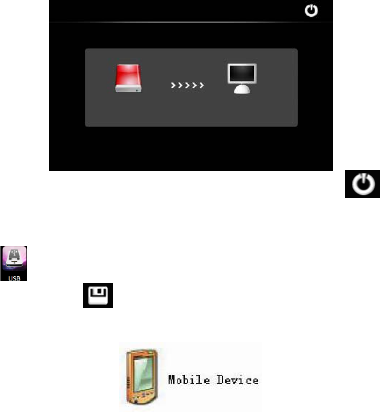
To disconnect the navigator from PC and enter charging mode, you may tab .
4. After communication, unplug the MINI USB cable.
◆
MS ACTIVESYNC
1. Tap in the system main interface to enter USB Option interface. Select MASS
ACTIVESYNC and tap to save the setting.
2. Install the application Mobile Device in a drive of PC. Then the following icon will
appear in the drive selection.
3. Connect the MINI USB terminal of the USB cable to the MINI USB port of the GPS
navigator and the standard USB terminal to the USB Host port of PC.
4. After the PC finds new hardware, double click the Mobile Device drive in the selection
area to enter the memory of GPS navigator for data transmission.
5. After transmission, unplug the USB cable.
[Attention] For data safety, please back up your system data in external storage. Our
company has no responsibility for lost or damage of system data.
[Note] If MASS STORAGE is selected while the GPS navigator is connected with PC,
other operations will be suspended.
[Attention] The following operations will stop suspend the communication of the system
and PC and unsaved data will be lost.
1. Unplugging the MINI USB cable;
2. Powering off the GPS navigator;
3. Resetting the system;
4. Tap the on close button on the top right.
34
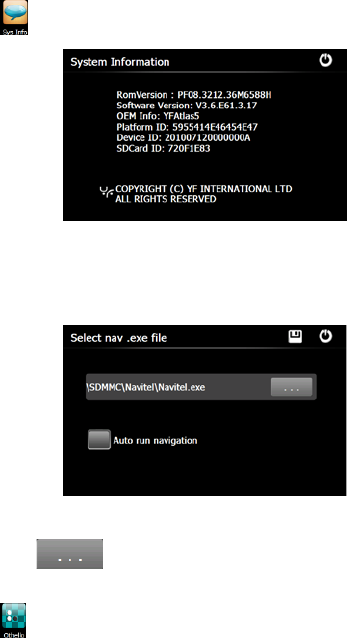
3.24 System Info
Tap in the system main interface to view the system information as follows.
The system information interface display information on hardware version, software
version, platform identity, device identity and SD card identity.
3.25 Navigation Path
Tap the "Nav Path" icon and enter into the following display interface:
1) Select the Auto Run Navigation, the device will run the Navigation software
automatically when tapping the GPS icon on the main menu.
2) Tap to select to run the navigation.exe files manually.
3.26 Othello
Tap in the system main interface to enter the interface as follows.
35
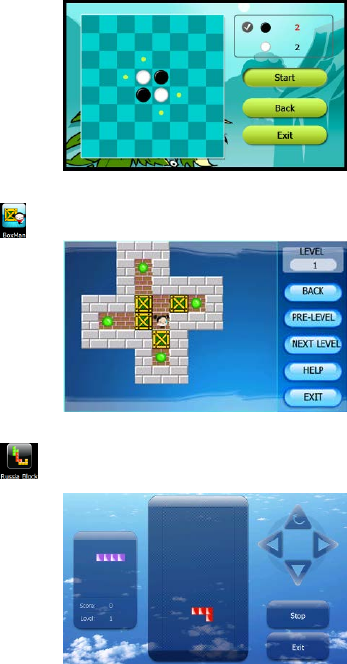
3.27 BoxMan
Tap in the system main interface to enter the interface as follows.
3.28 Russia Block
Tap in the system main interface to enter the interface as follows.
36
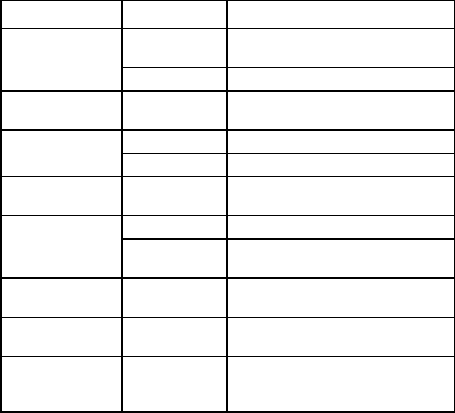
Appendix Troubleshooting
Please carry out the following operations in case of abnormal operation of the GPS
navigator. For further problems, please contact our customer service center.
Fault
Reason
Solution
Startup failure
Low battery
Supply external power and charge the
battery.
System down
Reset the GPS navigator.
Sudden power cut
Low battery
Supply external power and charge the
battery.
No/ vague display
Low backlight
Turn up the backlight.
Backlight off
Tap the screen with the touch pen.
Incorrect tapping
response
Touch screen not
calibrated
Recalibrate the screen.
No sounds
Low volume
Turn up the volume.
Poor contact of
earphone
Connect the earphone.
Communication with
PC
Poor USB
connection
Connect the USB cable.
GPS signals reception
failure
Weak GPS satellite
signal
About 3 minutes are needed for low
intensity of local GPS satellite signal.
Loss of map data
Accidental deletion
Contact your agent or distributor.
Input a new password after recovering the
GPS data.
4 FCC statement
1. This device complies with Part 15 of the FCC Rules.
Operation is subject to the following two conditions:
(1) This device may not cause harmful interference, and
37
(2) This device must accept any interference received, including
interference that may cause undesired operation.
2. Changes or modifications not expressly approved by the party
responsible for compliance could void the user’s authority to operate the
equipment.
NOTE: This equipment has been tested and found to comply with the limits
for a Class B digital device, pursuant to Part 15 of the FCC Rules. These
limits are designed to provide reasonable protection against harmful
interference in a residential installation. This equipment generates, uses and
can radiate radio frequency energy and, if not installed and used in
accordance with the instructions, may cause harmful interference to radio
communications. However, there is no guarantee that interference will not
occur in a particular installation.
If this equipment does cause harmful interference to radio or television
reception, which can be determined by turning the equipment off and on,
the user is encouraged to try to correct the interference by one or more of
the following measures:
-- Reorient or relocate the receiving antenna.
-- Increase the separation between the equipment and receiver.
-- Connect the equipment into an outlet on a circuit different from that to
which the receiver is connected.
-- Consult the dealer or an experienced radio/TV technician for help.
FCC Radiation Exposure Statement:
The device has been evaluated to meet general RF exposure requirement.
The device can be used in portable exposure condition without RF striction.
38